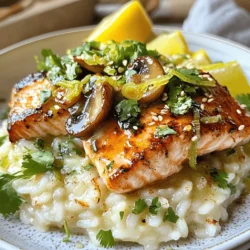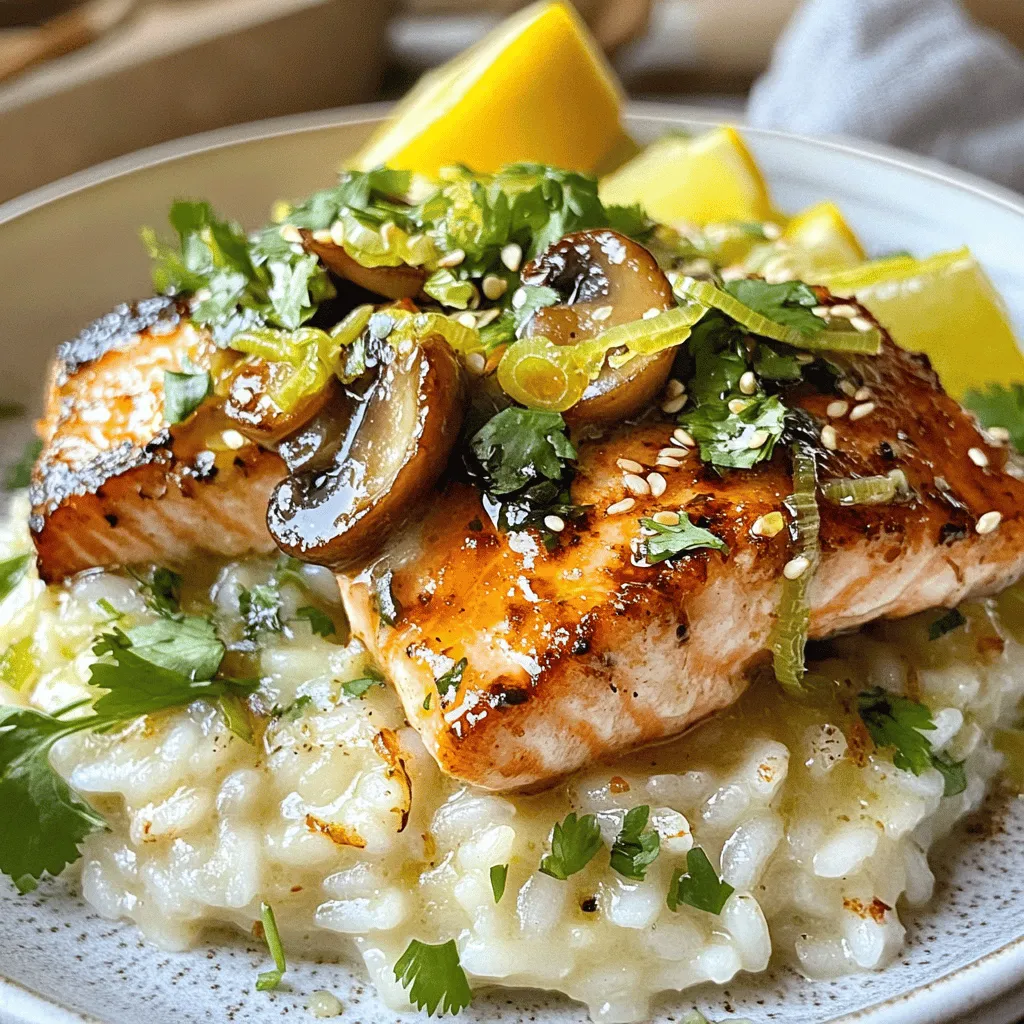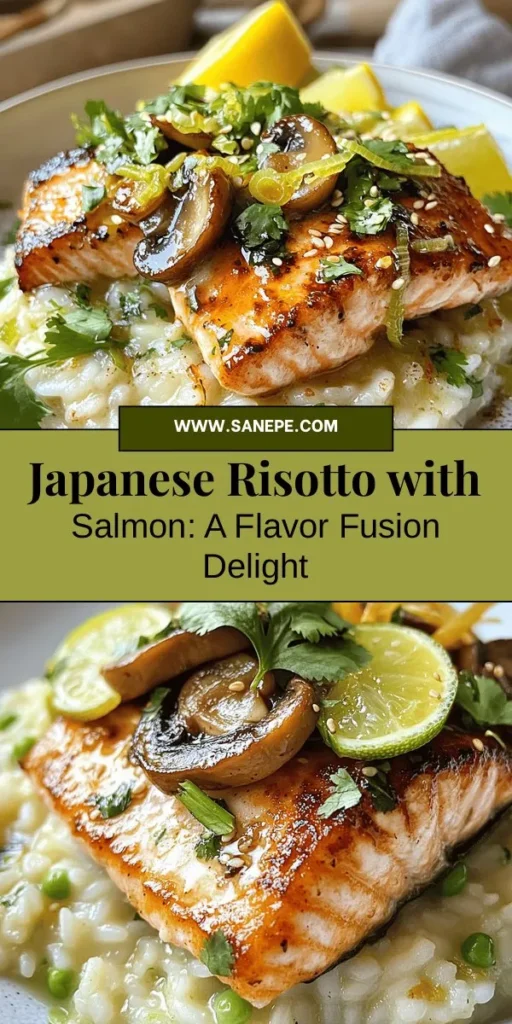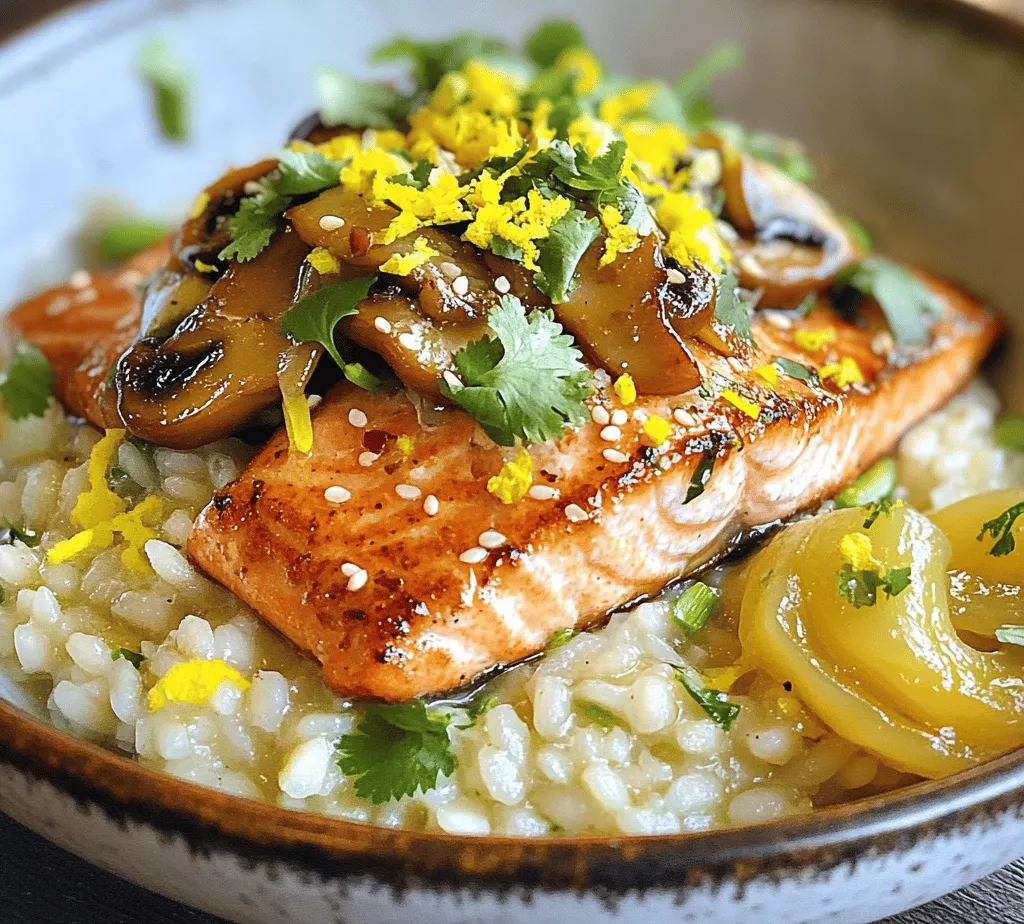Introduction
Japanese cuisine is renowned for its emphasis on fresh ingredients, delicate flavors, and meticulous presentation. Italian cuisine, on the other hand, celebrates rich, hearty dishes that often revolve around pasta and rice. When these two culinary worlds collide, the result is a tantalizing dish that is both comforting and innovative: Japanese Style Risotto with Seared Salmon. This delightful fusion not only showcases the creamy texture of traditional risotto but also incorporates distinctive Japanese flavors that elevate the dish to new heights.
In this recipe, the use of dashi broth, a cornerstone of Japanese cooking, provides a unique umami depth to the risotto, while the seared salmon adds a rich, buttery finish. The combination of these elements results in a beautifully balanced dish that tantalizes the taste buds and satisfies the soul. The creamy texture of the risotto, complemented by the tender, seared salmon, creates a dining experience that is both comforting and sophisticated.
Understanding Risotto
At its core, risotto is a creamy rice dish that is a staple in Italian cuisine. Unlike other rice dishes, risotto is characterized by its method of cooking, which involves slowly adding liquid to the rice while stirring continuously. This technique helps release the rice’s natural starches, resulting in a creamy and velvety texture that is truly satisfying.
The key ingredient in traditional risotto is Arborio rice, a short-grained rice known for its high starch content. This special type of rice is essential in achieving the characteristic creaminess of risotto. Arborio rice absorbs liquid beautifully, allowing the grains to plump up while maintaining a slight al dente bite. This unique texture is what sets risotto apart from other rice dishes, such as pilaf or fried rice, which often utilize long-grain varieties like basmati or jasmine.
In contrast, risotto’s creamy richness can be compared to rice dishes from other cuisines, such as the Spanish paella or the Indian khichdi. However, what makes risotto unique is not just its creamy texture but also its versatility; it can be flavored with an array of ingredients, allowing for endless variations and adaptations.
Exploring Japanese Ingredients
One of the most exciting aspects of creating Japanese Style Risotto with Seared Salmon is the incorporation of essential Japanese cooking staples. These ingredients play a crucial role in enhancing the dish’s overall flavor profile.
Dashi Broth
Dashi is a traditional Japanese broth that forms the foundation of many Japanese dishes. Made from simmering kombu (dried kelp) and katsuobushi (dried bonito flakes), dashi is revered for its umami flavor, which adds depth and complexity to any dish it touches. In this risotto recipe, dashi replaces the typical chicken or vegetable broth, infusing the dish with a subtle oceanic flavor that perfectly complements the seared salmon.
Mirin and Soy Sauce
Mirin, a sweet rice wine, and soy sauce are two other essential ingredients that enhance the flavors of the risotto. Mirin adds a touch of sweetness and a hint of acidity, balancing the dish’s richness, while soy sauce brings a savory depth and an earthy undertone. Together, these ingredients create a harmonious flavor profile that embodies the essence of Japanese cuisine.
Ingredients Breakdown
To create the perfect Japanese Style Risotto with Seared Salmon, you’ll need a selection of carefully chosen ingredients, each contributing its unique flavor and texture.
– Arborio Rice: As the star ingredient, Arborio rice is essential for achieving the creamy consistency characteristic of risotto. Its high starch content not only creates a velvety texture but also absorbs the flavors of the dashi broth beautifully. Nutritionally, Arborio rice is a good source of carbohydrates, providing energy for your body.
– Shiitake Mushrooms: These mushrooms add a rich, earthy flavor to the risotto. Shiitake mushrooms are packed with nutrients, including B vitamins, selenium, and polysaccharides that may support immune health. Their meaty texture also provides a satisfying contrast to the creaminess of the risotto.
– Fresh Salmon: Rich in omega-3 fatty acids, salmon not only contributes a buttery flavor but also offers numerous health benefits, including heart health support and anti-inflammatory properties. The searing process caramelizes the salmon’s surface, creating a delightful contrast with the creamy risotto.
– Ginger: Fresh ginger adds a hint of warmth and a zesty kick to the dish. This root is known for its anti-inflammatory and antioxidant properties, making it a nutritious addition to your meal.
– Fresh Herbs and Seasonings: To finish the dish, fresh cilantro and lime zest are added. Cilantro provides a refreshing burst of flavor, while lime zest adds brightness and a touch of acidity, elevating the overall taste profile of the risotto.
Step-by-Step Cooking Instructions
Now that we’ve explored the background and ingredients of our Japanese Style Risotto with Seared Salmon, let’s dive into the cooking process. This recipe may seem intricate, but with a little patience and attention to detail, you’ll create a dish that impresses both in flavor and presentation.
Step 1: Sautéing Mushrooms and Ginger
Begin by heating a drizzle of oil in a large, heavy-bottomed saucepan over medium heat. Once the oil is shimmering, add finely sliced shiitake mushrooms and minced ginger. Sauté these ingredients for about 3-4 minutes until the mushrooms are tender and lightly browned. This step builds a flavorful base for your risotto.
Step 2: Toasting Arborio Rice
Next, add 1 cup of Arborio rice to the saucepan, stirring to coat the grains in the oil and mushroom mixture. Toast the rice for about 2 minutes, allowing it to become slightly translucent. This step enhances the nutty flavor of the rice and prepares it for absorbing the liquids to come.
Step 3: Gradual Addition of Dashi Broth
Once the rice is toasted, it’s time to begin adding the dashi broth. Keep your dashi broth warm in a separate pot, as adding cold liquid can shock the risotto and affect its texture. Start by adding one ladle of warm dashi broth to the rice, stirring constantly. Allow the rice to absorb the liquid gradually, which will help release the starches and create that coveted creamy consistency.
Continue this process, adding more broth one ladle at a time and stirring frequently. This gradual method is key to achieving the perfect risotto texture. After about 18-20 minutes, the rice should be creamy and al dente, with a slight bite in the center.
As you prepare the risotto, keep an eye on the texture and adjust the amount of broth as needed. The goal is to have a creamy, cohesive dish that is not too soupy or overly dry.
Stay tuned for the next part of this article, where we will discuss the final steps of cooking the seared salmon and finishing touches for the risotto, ensuring you achieve a stunning and delicious meal that combines the best of both Japanese and Italian cuisines.
Cooking the Salmon to Achieve Ideal Doneness
Cooking salmon to perfection involves understanding a few essential techniques that ensure your fish is not only safe to eat but also deliciously moist and flavorful. The ideal doneness for salmon is typically medium, which means the center should be slightly translucent and should flake easily with a fork. This can be achieved by searing it on medium-high heat for about 3-4 minutes per side, depending on the thickness of the fillet.
Importance of Seasoning and Searing Technique
Seasoning your salmon fillet properly is key to enhancing its natural flavors. A simple mix of salt and freshly cracked black pepper is often sufficient, but you can also use a touch of soy sauce or a sprinkle of sesame seeds for that extra Japanese flair. When it comes to searing, start with a hot pan; this will help create that desirable crispy skin. Add a small amount of oil with a high smoke point, such as grapeseed or canola oil, to the pan before adding the salmon skin-side down. Avoid moving the fish too much during the cooking process, as this will disrupt the formation of the crust.
Tips on Ensuring Crispy Skin While Keeping the Fish Moist
To achieve that perfect crispy skin while keeping the flesh moist, follow these tips:
1. Pat the Skin Dry: Before cooking, make sure to pat the skin dry with a paper towel. Excess moisture will steam the fish rather than sear it.
2. Use a Cold Pan: Start with a cold pan and gradually heat it up. This technique allows the fat in the skin to render out slowly, leading to a crispier finish.
3. Press Down on the Fillet: When you first place the salmon in the pan, gently press down on it with a spatula for about 10 seconds. This helps the skin make better contact with the pan, promoting even crispness.
4. Cook Skin-Side First: Always cook the salmon skin-side first. This not only ensures crispy skin but also protects the delicate flesh from overcooking.
5. Finish in the Oven (Optional): For thicker fillets, consider finishing the cooking in the oven at 400°F (200°C) for an additional 5-7 minutes after searing both sides.
Serving Suggestions
The presentation of your Japanese-style risotto with seared salmon can elevate the dining experience and reflect the dish’s thoughtful preparation.
Presentation Ideas for an Appealing Dish
1. Layering: Start with a generous scoop of the risotto at the center of the plate. Lay the seared salmon fillet on top, allowing some of the risotto to peek out from underneath.
2. Color Contrast: Utilize vibrant vegetables such as steamed asparagus or sautéed spinach around the risotto to add color. Brightly colored garnishes like microgreens or edible flowers can also enhance visual appeal.
3. Sauce Drizzle: A light drizzle of soy sauce reduction or a citrus-infused ponzu sauce around the plate can add a sophisticated touch.
Suggested Pairings with Sides or Beverages
Pair your risotto with sides that complement the dish’s flavors:
– Side Dishes: Lightly dressed mixed greens or a cucumber salad can offer a refreshing contrast to the richness of the risotto. Grilled vegetables or a simple miso soup can also round out the meal beautifully.
– Beverages: For beverages, consider serving a chilled glass of Sauvignon Blanc or a light Japanese sake. Both will enhance the flavors of the salmon and the creamy risotto without overpowering them.
Optional Garnishes and Their Impact on Flavor and Appearance
Garnishes can significantly impact both the flavor and presentation of your dish. Here are a few ideas:
– Chopped Chives or Green Onions: These add a fresh, mild onion flavor and a pop of color.
– Sesame Seeds: Toasted sesame seeds provide a nutty flavor and a delightful crunch.
– Lemon Zest: A sprinkle of lemon zest can brighten the dish, enhancing its freshness.
– Microgreens: These not only add visual appeal but also a range of flavors depending on the type used, such as basil or radish microgreens.
Culinary Techniques to Master
Mastering a few culinary techniques can significantly enhance the quality of your Japanese-style risotto with seared salmon.
Importance of Stirring in Risotto and Its Effect on Texture
Stirring is essential when cooking risotto. The constant agitation helps release the starches from the rice, creating that signature creamy texture. Aim to stir the risotto every few minutes, allowing it to absorb the broth gradually. This slow cooking process also helps prevent the rice from becoming mushy, maintaining its al dente bite.
Techniques for Searing Fish to Achieve a Restaurant-Quality Finish
To achieve a restaurant-quality finish when searing your salmon, follow these techniques:
1. Temperature Control: Make sure your pan is hot before adding the salmon. A properly heated pan will create a nice sear, while a cold one will cause the fish to stick.
2. Fat Choice: Use fats that can handle high heat, such as clarified butter or avocado oil. These fats not only help achieve a perfect sear but also add flavor.
3. Let It Rest: After cooking, let the salmon rest for a couple of minutes before serving. This resting period allows the juices to redistribute throughout the fish, ensuring a moist and flavorful bite.
Understanding the Balance of Flavors in a Japanese-Inspired Dish
Balance is crucial in Japanese cuisine, where flavors should complement rather than overpower one another. In your risotto, the umami from the fish and the creaminess of the rice should be balanced with the brightness of any garnishes, such as citrus or fresh herbs. Consider incorporating miso or dashi in the risotto broth to deepen the umami flavor profile, creating a cohesive taste experience.
Health Benefits of the Dish
This Japanese-style risotto with seared salmon is not only a delicious culinary fusion but also a nutritious choice.
Overview of the Nutritional Value of the Ingredients
– Salmon: Rich in omega-3 fatty acids, high-quality protein, and essential vitamins such as B12 and D. These nutrients support heart health and brain function.
– Arborio Rice: A source of carbohydrates that provide energy, while also containing some protein and fiber.
– Vegetables and Broth: Fresh vegetables add vitamins, minerals, and antioxidants, while the broth increases hydration and flavor without adding excessive calories.
Benefits of Incorporating Fish into a Balanced Diet
Incorporating fish like salmon into your diet provides numerous health benefits. Omega-3 fatty acids found in salmon help reduce inflammation, lower blood pressure, and promote overall heart health. Fish is also easier to digest compared to red meat, making it a lighter protein option that still delivers essential nutrients.
The Role of Vegetables and Herbs in Promoting Health
Adding a variety of vegetables not only enhances the dish’s flavor but also boosts its nutritional profile. Leafy greens, for example, are rich in vitamins A, C, and K, while herbs like parsley or chives can provide additional antioxidants. This combination contributes to a well-rounded meal that supports overall health.
Cultural Significance of the Dish
The melding of Japanese and Italian cuisines in this dish symbolizes the beauty of culinary fusion.
Discussion of the Cultural Blend of Japanese and Italian Cuisines
Japanese and Italian cuisines, while distinct, share a deep appreciation for fresh, high-quality ingredients. The use of rice in risotto parallels the importance of rice in Japanese cooking. Both cultures value umami as a core flavor, making this fusion dish a natural convergence.
How This Dish Represents a Modern Culinary Fusion
In an era where culinary boundaries are increasingly blurred, dishes like Japanese-style risotto with seared salmon exemplify modern fusion cuisine. Such recipes draw from traditional techniques and ingredients, inviting chefs and home cooks alike to experiment and create something unique.
Insights into the Growing Popularity of Fusion Cuisine
Fusion cuisine has gained momentum in recent years, appealing to adventurous eaters who seek new experiences. This trend reflects a globalized food culture where flavors from different regions come together, encouraging culinary innovation. As diners become more open to trying new combinations, dishes like this risotto will continue to thrive and evolve.
Conclusion
The Japanese-style risotto with seared salmon is a celebration of flavors and techniques, bringing together the best of both worlds. The creamy risotto, perfectly seared salmon, and thoughtful garnishes create an unforgettable dining experience that is both visually stunning and satisfying to the palate.
This dish invites you to explore the world of fusion cooking, encouraging you to experiment with flavors and techniques from different culinary traditions. Whether you are a seasoned chef or a home cook looking to expand your repertoire, creating this dish will bring joy and warmth to your kitchen.
Embrace the art of fusion cooking and enjoy the process of crafting original dishes at home. You may find that blending cultures not only enhances your culinary skills but also enriches your appreciation for diverse flavors and culinary traditions. Happy cooking!



